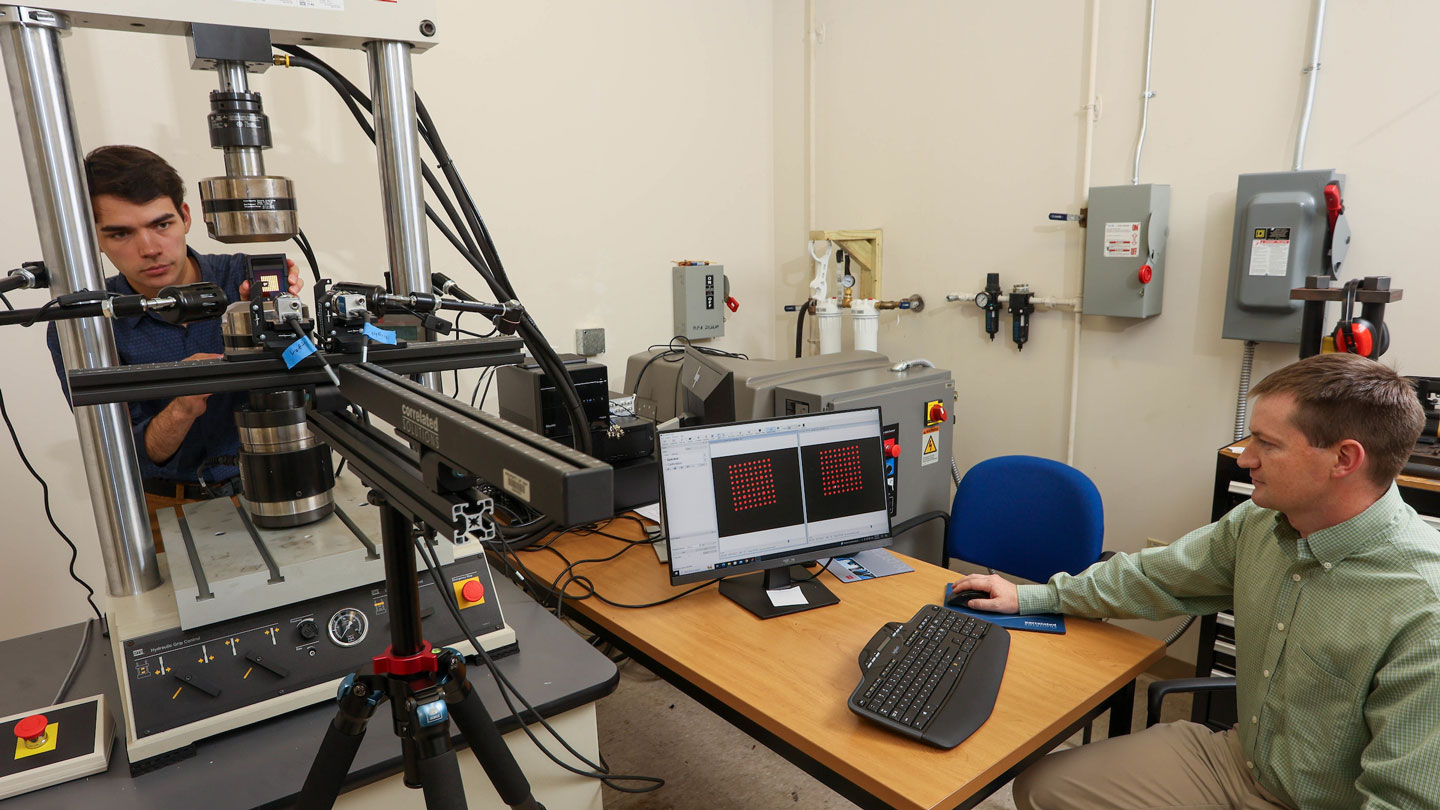
Dr. Nathan Spulak (R), assistant professor of Mechanical and Aerospace Engineering, works with UAH summer research junior Tyler Robertson (L).
Michael Mercier | UAH
Dr. Nathan Spulak, an assistant professor at The University of Alabama in Huntsville (UAH), has been awarded a $299,000 National Science Foundation EPSCoR Research Infrastructure Improvement fellowship to enhance safety for earth, air and space vehicles and habitation structures by examining the characteristics of composite materials. The researcher is the principal investigator on the project, a collaboration between UAH and the NASA Glenn Research Center in Cleveland, Ohio, set to run through December 2026. The effort aims to contribute to the widespread adoption of fiber-reinforced composites (FRC) as a structural material, leading to more fuel-efficient transportation, reduced pollution and faster and more maneuverable aircraft, as well as corrosion-resistant FRCs in marine environments and internal biomedical implants.
Spulak is a faculty member in the Department of Mechanical and Aerospace Engineering at UAH, a part of The University of Alabama System.
“I came to propose this project primarily due to my interest in enhancing vehicle crashworthiness, in order to keep people safe and protect human life,” the researcher says. “Combined experimental testing and accurate numerical modeling is critical to designing safe automotive vehicles, aircraft, space vehicles and long-term space habitation structures. While fiber-reinforced composite materials offer attractive benefits for these applications, including a high strength-to-weight ratio and corrosion resistance, they also exhibit highly complex mechanical responses and fracture behavior that makes designing safe vehicles and structures challenging.”
The improved fuel efficiency, battery range and cargo-carrying capacity provided by lightweight FRC structural components has the capability to revolutionize transportation in the automotive, aviation and maritime sectors, the researcher reports.
“A key design criteria for such applications is the behavior of FRC structures during crash and impact events – yet, to date, even the most state-of-the art predictive models struggle to accurately capture the mechanical response of FRCs under these scenarios. There is currently no established experimental or analytical methodology capable of generating the desired level of accuracy across the broad range of loading scenarios that are possible during such events,” Spulak says.
Characterizing FRC behavior is challenging due to the high level of anisotropy exhibited by these materials, a term in structural engineering that refers to how the properties of a material can differ when measured along different axes. Mechanical properties like strength and stiffness will vary depending on the orientation of the applied loads relative to the direction of the fibers in the materials.
FRCs also exhibit multiple possible fracture mechanisms such as fiber breaking, matrix cracking, and matrix-fiber delamination. “To make things even more complicated, the material behavior can change if it is loaded slowly compared to the high-rate loading that will occur during vehicle crashes or debris impacts,” Spulak notes.
High-rate loading refers to applying loads to the material very rapidly, often within the span of a few milliseconds or even microseconds. This rapid loading can result in significantly different behavior of the material compared to if loading were to be applied in a static or gradual manner, making understanding how the material behaves when subjected to high-rate loading for accurate analysis and design of vehicles or debris impact shielding structures a critical component of the research.
“Additionally, high-rate loading can cause temperature increases in the material that could lead to thermal softening, further altering the mechanical strength and fracture response,” the researcher says. “All this complexity must be experimentally analyzed, and then sophisticated simulation models capable of accurately capturing this complexity must be developed in order to safely design the next-generation of vehicles and structures using composites.”
Spulak’s project aims to address these challenges by performing dynamic impact and crush tests in collaboration with the Glenn Research Center, then incorporating the rate and temperature effects into state-of-the-art material models for finite element analysis.
“The project will develop novel experimental and analytical methodologies to more accurately and efficiently determine the complex material properties of FRCs and assess how these properties vary with respect to the strain rate and temperature,” the researcher says. “The insights gained will enable a greater understanding of the fundamental mechanisms behind FRC deformation and fracture behavior, allowing for more informed design of novel FRC materials with enhanced performance.”
The EPSCoR program seeks to promote scientific progress nationwide by establishing partnerships among academic institutions, government, industry and non-profit sectors to promote sustainable improvements in a jurisdiction's research infrastructure, research and development capacity and competitiveness. The fellowship builds research capacity and transforms career trajectories of investigators in EPSCoR-eligible jurisdictions.